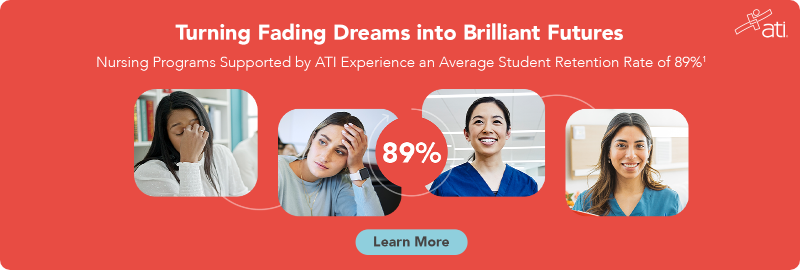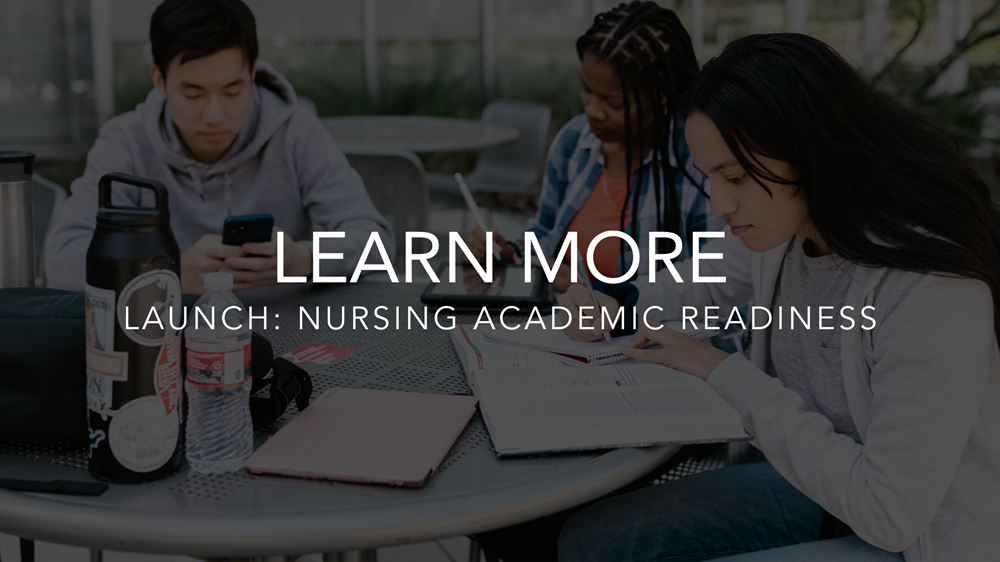Reducing attrition in first-year nursing students through early identification and action
Early identification of academic risk among nursing students
The drive for solutions to the U.S. nursing shortage has momentum on multiple fronts, from hospital board rooms to think tanks to Congress. But the most pivotal path may be the one that starts at the threshold: the first year of nursing school.
Throughout the country, many first-year students are entering nursing programs without sufficient academic and study skills. In a 2022 ATI survey of nurse educators, 71% reported significant academic struggles among first-year students, and 46% reported increased rates of first-year attrition.
This discouraging trend has prompted some nursing programs to hire new staff to coach students who are struggling. Others have asked faculty to volunteer their time to teach after-hours workshops to at-risk students. Neither of these strategies is ideal for most institutions. Instead, most programs are looking for an approach that can be implemented without additional demands on educators or staffing budgets. This solution is available from ATI.
Launch: Nursing Academic Readiness® is an evidence-based, customized resource that brings the academic and study skills of new nursing students to necessary levels — without additional hires and in a way that eases burdens on faculty, rather than increasing them. This powerful student-paced academic support program can reduce first-year attrition and ensure success for new nursing students. By providing Launch: Nursing Academic Readiness to students at risk for attrition, programs can ensure that more first-year students progress through a nursing curriculum.
How can faculty identify nursing students who are at risk? Let’s explore the answers with two nurse education experts: Pamela Osuri, RN, MSN, CNS, Director of Test Prep Client Success at ATI Nursing Education, and Beth Cusatis Phillips, PhD, RN, CNE, CHSE, Strategic Nursing Advisor at ATI Nursing Education.
How to identify signs of academic risk in nursing students
 Significant evidence demonstrates that early identification of at-risk students allows nursing faculty to implement strategies that help students overcome their specific barriers to academic progress.1 Research also shows that after a barrier is identified, the implementation of individualized support strategies2 — the core feature of Launch: Nursing Academic Readiness — enhances the likelihood of success.
Significant evidence demonstrates that early identification of at-risk students allows nursing faculty to implement strategies that help students overcome their specific barriers to academic progress.1 Research also shows that after a barrier is identified, the implementation of individualized support strategies2 — the core feature of Launch: Nursing Academic Readiness — enhances the likelihood of success.
“It is important to identify at-risk students early so that faculty can be a support to them from the start,” Osuri said. “When these students are not identified, they feel siloed and struggle to meet expectations that can lead to attrition.”
Students who are academically at risk may signal their struggles in a range of ways — a mirroring of the complex root causes of those difficulties. Many states and educational bodies have formalized identification criteria for who is at risk. For example, in Montana, an at-risk student is defined as any student who “is affected by environmental conditions that negatively impact the student's educational performance or threaten a student's likelihood of promotion or graduation. These environmental conditions might include economic disadvantage, transience, family disruptions, and so forth.”
In nursing education, identifying students who are likely to have difficulty with the curriculum helps assure that students and programs are making decisions that support the targeted outcome of graduation and licensure.
Take a deep dive into nursing admission & retention issues
Among nursing students, specific signs of academic risk may include:
- a low TEAS score on first attempt
- a need to repeat pre-nursing courses
- a need for learning accommodations
- poor reading comprehension or English skills
- weaknesses in math proficiency
- no prior classes in anatomy and physiology, or poor performance in this subject.
For many students, difficult-to-control life circumstances are also significant factors in their academic progress. “Being at academic risk is connected to the environmental conditions that negatively impact educational performance or the likelihood of stress,” Dr. Phillips said. “It can be related to economic disadvantage, family disruptions, mental health issues, low income, and more.”
Early customized support from a nursing program can help students overcome the challenges associated with these issues, Dr. Phillips said. “If students can gain support early, based on their individualized needs, they can turn their life around and find supports that will help them be successful in nursing school.”
How faculty can encourage nursing students to reach out for help
Any discussion of improving academic performance in at-risk students must place this truth at the forefront: Evidence shows that most at-risk students do not seek faculty support.3-5 This means programs must be proactive in encouraging student communication about their challenges.
“It’s important to help students feel that faculty are approachable,” Osuri said. “Provide office hours that are flexible enough for student schedules, be available for conversation before and after class, and model caring behaviors that demonstrate acceptance.”
For some students, overcoming struggles — whether they be academic, economic, or social — can feel impossible. It’s important for faculty to look beyond what may be a student’s resistant “I don’t need your help” exterior to build a relationship that will help them feel at ease sharing information about their challenges.
Dr. Phillips pointed out that multiple possibilities exist about the stressors a student faces and the experiences that have shaped their beliefs and behaviors. These may include:
- fear of retribution in grading or curriculum progression
- fear of appearing less knowledgeable than classroom peers
- lack of understanding that it is acceptable to ask for help
- belief that they don’t deserve help or support
- poor self-confidence.
“Don't assume a student doesn't want help,” Dr. Phillips said. “They may feel too embarrassed to approach you. Sometimes all it takes is a conversation or series of conversations to help them feel comfortable enough to open up.”
How to reduce first-year attrition without additional faculty burden
Given the significant demands on nursing faculty, finding the time and resources to remediate at-risk students on foundational subjects can be burdensome. Modifying lectures and assignments to teach students with markedly different levels of comprehension and understanding affects how the entire class learns and progresses.
“When students aren’t keeping pace academically, faculty are challenged to support beyond the minimum course requirements,” Osuri said. “They cannot always mentor their high-risk students, causing students to flounder or seek tutoring outside of school. Additionally, nurses who are new to teaching may not be equipped to support students with increased learning needs.”
ATI developed Launch: Nursing Academic Readiness to help prepare at-risk nursing students to succeed in a nursing program without adding faculty responsibilities. Using a customized approach that pairs a student with an ATI Educator, this program provides early intervention to address academic and study weaknesses.
“Launch: Nursing Academic Readiness has two major roles,” Osuri explained. The first is to mentor the student and boost their confidence. The second is to build an individualized study plan, based on each student’s outcomes on ATI tutorials and assessments, that helps ensure the student is ready for nursing school.”
To prepare first-year students for academic progress in a nursing curriculum, Launch: Academic Readiness provides the following:
- a customized student-paced study plan, delivered over 6 weeks
- 1:1 coaching by an ATI educator who supports each student from start to finish
- formative and summative evaluative feedback from the ATI educator
- quizzing at the conclusion of each module, to ensure comprehension
- animations, videos, diagrams and interactive tools that explain key concepts using engaging teaching techniques
- tutorials, quizzes, and assessments that build essential knowledge and understanding in reading, math, science, English, anatomy & physiology
- test-taking and study skills training
- an end-of-program assessment to gauge overall comprehension and determine readiness to progress to a Fundamentals of Nursing class.
“Launch: Nursing Academic Readiness is a win-win for both students and faculty,” Dr. Phillips said. “It helps students prepare for nursing school by building foundational knowledge and improving test-taking and study skills, and it helps faculty ensure that students are ready for the science, reading, and math knowledge that is expected on day one.”
The engaging digital delivery of the program is an important element of its design, because it reflects the characteristics of today’s learners.
“With technological advances, students learn differently and at a different pace than before,” Dr. Phillips said. “Launch: Nursing Academic Readiness meets the students where they are and pulls them up to where they need to be. Faculty don't have the time and don't get paid to help pre-nursing students, so knowing a student successfully completed this program helps faculty help their students.”
Nursing programs are seeking to bridge the widening gap between student qualification for program admission and actual readiness to begin the nursing curriculum. Launch: Nursing Academic Readiness is a resource that can help faculty achieve this.
“We need to grow our professional nursing population, and short-term challenges should not be a hindrance,” Osuri said. “Resources like Launch: Nursing Academic Readiness increase the likelihood that more students will have success in nursing school and become licensed nurses.”
Learn more about Launch: Nursing Academic Readiness
References
1. Merritt, S.M. (2020). Supporting at-risk nursing students to increase their final course grade. Teaching and Learning in Nursing, 16 (1), 74-80. https://doi.org/10.1016/j.teln.2020.09.005
2. Jeffreys, M.R. (2015). Jeffreys’s Nursing Universal Retention and Success Model: Overview and action ideas for optimizing outcomes A-Z. Nurse Education Today, 35 (3), 425-431. https://doi.org/10.1016/j.nedt.2014.11.004
3. Custer, N. (2016). Remediation 101: Strategies for nurse educators. Teaching and Learning in Nursing, 11 (4), 166-170. https://doi.org/10.1016/j.teln.2016.05.006
4. Hoeve, Y.T., et al. (2017). Dreams and disappointments regarding nursing: Student nurses’ reasons for attrition and retention. A qualitative study design. Nurse Education Today, 54, 28-36. https://doi.org/10.1016/j.nedt.2017.04.013
5. Pitt, P., et al. (2012). Factors influencing nursing students’ academic and clinical performance and attrition: An integrative literature review. Nurse Education Today, 32 (8), 903-913. https://doi.org/10.1016/j.nedt.2012.04.011


